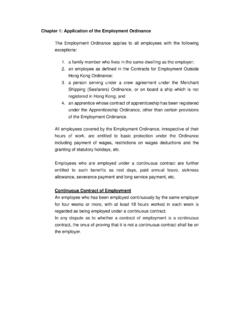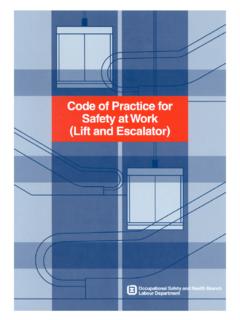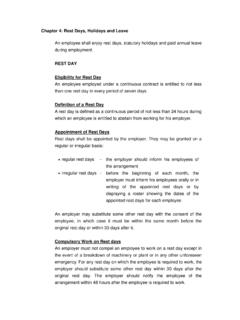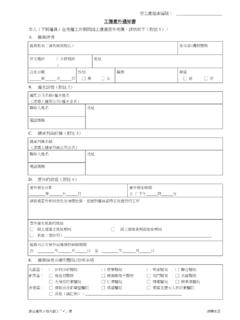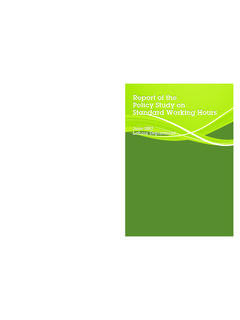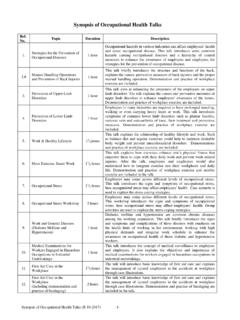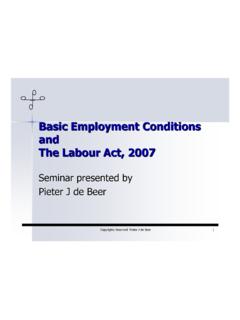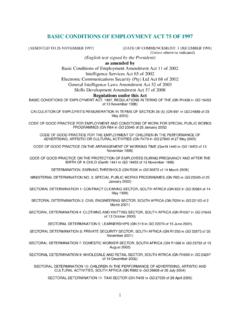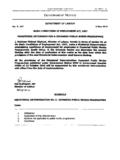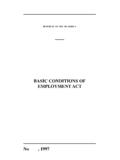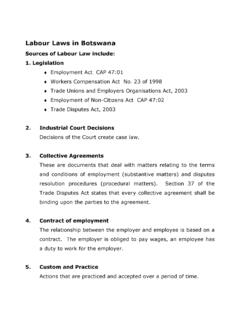Transcription of A Concise Guide to the Employment Ordinance - …
1 A Concise Guide to the Employment Ordinance Labour Department 1 Table of Contents Foreword 2 Chapter 1 Application of the Employment Ordinance 3 Chapter 2 Contract of Employment 4 Chapter 3 Wages 7 Chapter 4 Rest Days, Holidays and Leave 11 Chapter 5 Sickness Allowance 19 Chapter 6 Maternity Protection 23 Chapter 7 Paternity Leave 28 Chapter 8 End of Year Payment 33 Chapter 9 Termination of Contract of Employment 35 Chapter 10 Employment Protection 40 Chapter 11 Severance Payment and Long Service Payment 45 Chapter 12 Protection against Anti-union Discrimination 51 Chapter 13 Employers Criminal Liability in Failing to Pay an Award of the Labour Tribunal or Minor Employment Claims Adjudication Board 52 Appendix 1 A Guide to the Calculation of Relevant Statutory Entitlements on the Basis of the 12-Month Average Wages with Examples 56 Appendix 2 Enquiries 662 Foreword This Guide sets out in simple terms the main provisions of the Employment Ordinance (Cap.)
2 57). It should be noted that the Ordinance itself remains the sole authority for the provisions of the law explained. Please refer to Appendix 2 for enquiries services. September 2019 3 Chapter 1: Application of the Employment Ordinance The Employment Ordinance applies to all employees with the following exceptions: 1. a family member who lives in the same dwelling as the employer; 2. an employee as defined in the Contracts for Employment Outside Hong Kong Ordinance ; 3. a person serving under a crew agreement under the Merchant Shipping (Seafarers) Ordinance , or on board a ship which is not registered in Hong Kong; and 4. an apprentice whose contract of apprenticeship has been registered under the Apprenticeship Ordinance , other than certain provisions of the Employment Ordinance . All employees covered by the Employment Ordinance , irrespective of their hours of work, are entitled to basic protection under the Ordinance including payment of wages, restrictions on wages deductions and the granting of statutory holidays, etc.
3 Employees who are employed under a continuous contract are further entitled to such benefits as rest days, paid annual leave, sickness allowance, severance payment and long service payment, etc. Continuous Contract of Employment An employee who has been employed continuously by the same employer for four weeks or more, with at least 18 hours worked in each week is regarded as being employed under a continuous contract. In any dispute as to whether a contract of Employment is a continuous contract, the onus of proving that it is not a continuous contract shall be on the employer. 4 Chapter 2: Contract of Employment A contract of Employment is an agreement on the Employment conditions made between an employer and an employee. The agreement can be made orally or in writing and it includes both express and implied terms.
4 Employers and employees are free to negotiate and agree on the terms and conditions of Employment provided that they do not violate the provisions of the Employment Ordinance . Any term of an Employment contract which purports to extinguish or reduce any right, benefit or protection conferred upon the employee by this Ordinance shall be void. Information on conditions of Service Before Employment begins, an employer must inform each employee clearly the conditions of Employment under which he is to be employed with regard to: 1. wages (including rate of wages, overtime rate and any allowance, whether calculated by piece, job, hour, day, week or otherwise); 2. wage period; 3. length of notice required to terminate the contract; and 4. if the employee is entitled to an end of year payment, the end of year payment or proportion and the payment period.
5 If the contract of Employment is in writing, the employer shall give one copy of the written contract to the employee for retention and reference. If the contract of Employment is not in writing, the employer shall provide the employee with such information in writing if the employee, before such Employment is entered into, makes a written request. Whenever there is any change in the conditions of service, whether these have merely been proposed to an employee or are actually in force, the employer shall inform him in an intelligible manner. If such change to conditions of service is in writing or upon the written request from the employee, a copy of the written amendment must be provided to the employee. 5 NOTE: Statutory entitlements such as holiday pay, annual leave pay, sickness allowance, maternity leave pay and paternity leave pay are calculated on the basis of wages, particulars of which are established by the terms of Employment contracts.
6 Employers and employees should clearly understand the wage components (for example, commission, allowance, etc), wage rate, conditions and arrangements for payment, etc. Duration of Employment Contract In the absence of any express agreement to the contrary, every contract of Employment which is a continuous contract is deemed to be a contract for one month and renewable from month to month. Wage and Employment Records Every employer must at all times keep a record setting out the wage and Employment history of each employee covering the period of his Employment during the preceding 12 months. The record should include the following information of the employee: 1. name and identity card number; 2. date of commencement of Employment ; 3. job title; 4. wages paid in respect of each wage period; 5.
7 Wage period; 6. total number of hours worked in each wage period (if applicable*); 7. periods of annual leave, sick leave, maternity leave, paternity leave and holidays entitled and taken, together with details of payments made in respect of such periods; 8. amount of end of year payment and the period to which it relates (if applicable); 9. period of notice required for termination of contract; 10. date of termination of Employment (if applicable). * For details, please refer to the Concise Guide to Statutory Minimum Wage published by the Labour Department. This Guide book can be downloaded from the homepage of the Labour Department ( ) or obtained at the Offices of the Labour Relations Division of the Labour Department. 6 The wage and Employment records must be kept at the employer s place of business or at the place where the employee is employed, and they should also be kept for a period of another six months after the employee ceases to be employed.
8 NOTE: Employers should keep proper records in relation to employees attendance, leave and wages, etc for the purpose of calculating statutory entitlements. To safeguard their own rights and benefits, employees should also keep proper records in relation to their attendance, leave and wages, etc. Offences and Penalties An employer who fails to keep the above record is liable to prosecution and, upon conviction, to a fine of $10,000. Officers of the Labour Department may inspect the above record, inquire any person or seize anything which may appear to be evidence of an offence under the Employment Ordinance . Any person who fails to comply with the requirements of the officers of the Labour Department is liable to prosecution and, upon conviction, to a fine of $100,000 and to imprisonment for one year. 7 Chapter 3: Wages Definition "Wages" means all remuneration, earnings, allowances, tips and service charges, however designated or calculated, payable to an employee in respect of work done or work to be done.
9 Allowances including travelling allowances, attendance allowances, commission and overtime pay are within the definition of wages. However, it does not include: 1. the value of any accommodation, education, food, fuel, water, light or medical care provided by the employer; 2. employer's contribution to any retirement scheme; 3. commission, attendance allowance or attendance bonus which is of a gratuitous nature or is payable only at the discretion of the employer; 4. non-recurrent travelling allowance or the value of any travelling concession or travelling allowance for actual expenses incurred by the Employment ; 5. any sum payable to the employee to defray special expenses incurred by him by the nature of his Employment ; 6. end of year payment, or annual bonus which is of a gratuitous nature or is payable only at the discretion of the employer; 7.
10 Gratuity payable on completion or termination of a contract of Employment . An employee's entitlements to end of year payment, maternity leave pay, paternity leave pay, severance payment, long service payment, sickness allowance, holiday pay, annual leave pay and payment in lieu of notice are calculated according to the above definition of wages. Overtime pay should also be included in calculating the above payments if : it is of a constant character; or its monthly average over the past 12 months is not less than 20% of the average monthly wages of the employee during the same period. 8 Deductions from Wages An employer is prohibited from deducting wages from his employee, except under the following circumstances: 1. deductions for absence from work. The sum to be deducted should be proportionate to the period of time the employee is absent from work; 2.

